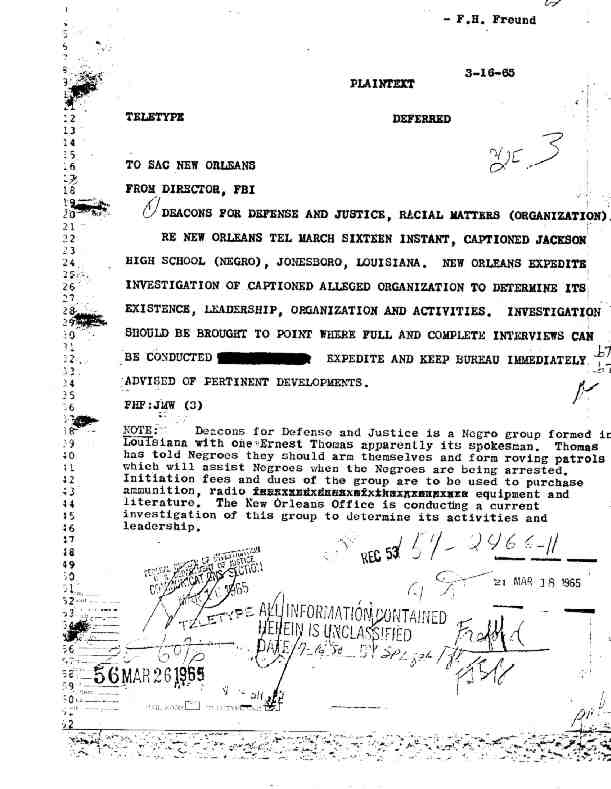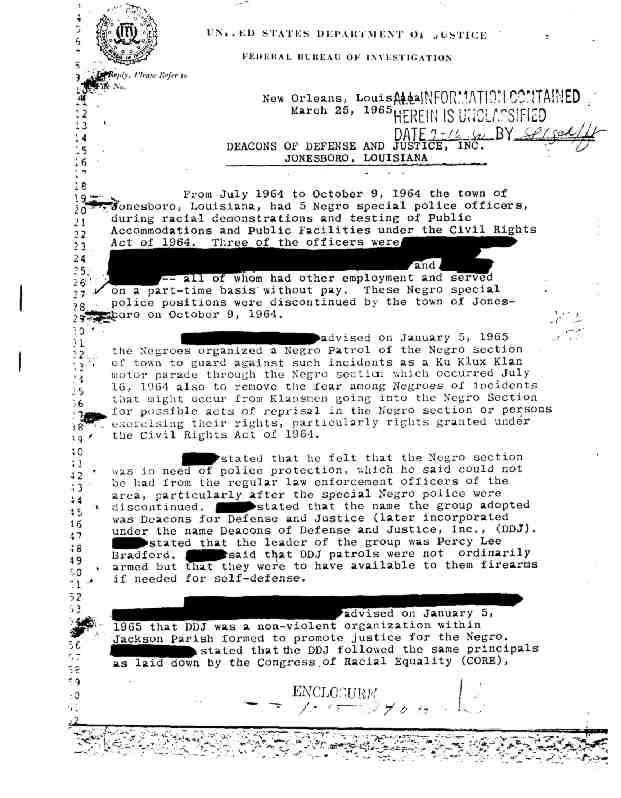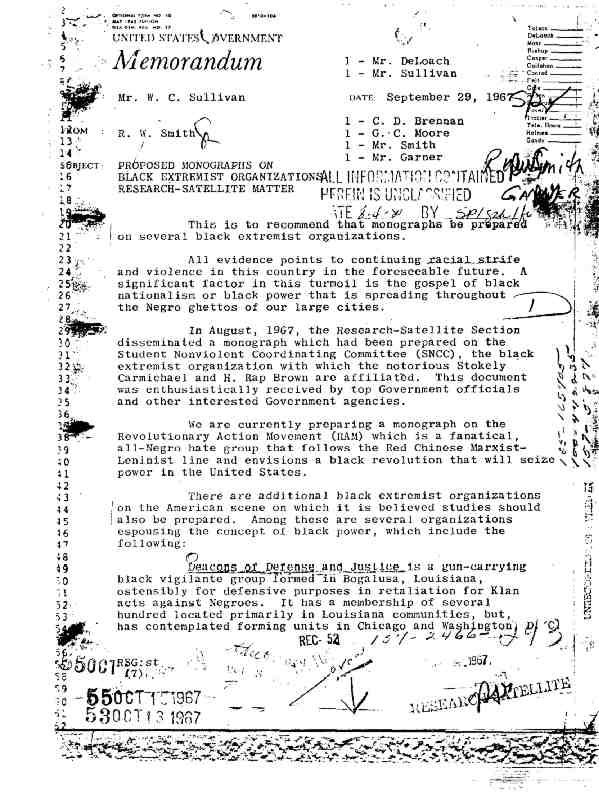Deacons for Defense and Justice
From Wikipedia, the free encyclopedia
The Deacons for Defense and Justice is an armed self defense African American civil rights organization in the U.S. Southern states during the 1960s. Historically, the organization practiced self-defense methods in the face of racist oppression that was carried out by Jim Crow Laws; local and state agencies; and the Ku Klux Klan. Many times the Deacons are not written about or cited when speaking of the Civil Rights Movement because their agenda of self-defense, in this case, using violence (if necessary) did not fit the image of strict non-violence agenda that leaders like Dr. Martin Luther King Jr. preached about the Civil Rights Movement. Yet, there has been a recent debate over the crucial role the Deacons and other lesser known militant organizations played on local levels throughout much of the rural South. Many times in these areas the Federal government did not always have complete control over to enforce such laws like the Civil Rights Act of 1964 or Voting Rights Act of 1965.Currently, this group is "calling for arms" in black communities both mentally and physically through the Second Amendment to the United States Constitution.
The Deacons are a segment of the larger tradition of Black Power in the United States. This tradition began with the inception of African slavery in the U.S. and began with the use of Africans as chattel slaves in the Western Hemisphere. Stokely Carmichael defines Black Power as, “The goal of black self-determination and black self-identity—Black Power—is full participation in the decision-making processes affecting the lives of black people, and recognition of the virtues in themselves as black people.”[1] Those of us who advocate Black Power are quite clear in our own minds that a “non-violent” approach to civil rights is an approach black people cannot afford and a luxury white people do not deserve.[1] This refers to the idea that the traditional ideas and values of the Civil Rights Movement placated to the emotions and feelings of White liberal supporters rather than Black Americans who had to consistently live with the racism and other acts of violence that was shown towards them.
The Deacons were a driving force of Black Power that Stokely Carmichael echoed. Carmichael speaks about the Deacons when he writes, “Here is a group which realized that the ‘law’ and law enforcement agencies would not protect people, so they had to do it themselves...The Deacons and all other blacks who resort to self-defense represent a simple answer to a simple question: what man would not defend his family and home from attack?”[1] The Deacons, according to Carmichael and many others were the protection that the Civil Rights needed on local levels, as well as, the ones who intervened in places that the state and federal government fell short.
Contents[hide] |
[edit] History
The Deacons were not the first champions of armed-defense during the Civil Rights Movement. Many activists and other proponents of non-violence protected themselves with guns. Fannie Lou Hamer, the eloquently blunt Mississippi militant who outraged Lyndon B. Johnson at the 1964 Democratic Convention, confessed that she kept several loaded guns under her bed.[2] Others such as Robert F. Williams also practiced self-defense. Williams transformed his local NAACP branch into an armed self-defense unit, for which transgression he was denounced by the NAACP and hounded by the federal government (he found asylum in Cuba).[2]Dr. Martin Luther King Jr. was no stranger to the idea of self-defense. According to Annelieke Dirks, “Even Martin Luther King Jr.—the icon of nonviolence—employed armed bodyguards and had guns in his house during the early stages of the Montgomery Bus Boycott in 1956. Glenn Smiley, an organizer of the strictly nonviolent and pacifist Fellowship of Reconciliation (FOR), observed during a house visit that the police did not allow King a weapon permit, but that ‘the place is an arsenal."[3] Efforts from those like Smiley convinced Dr. King that any sort of weapons or “self-defense” could not be associated with someone like him in the position that he held. Dr. King agreed.
In many areas of the “Deep South” the federal and state governments had no control of local authorities and groups that did not want to follow the laws enacted. One of these groups, the Ku Klux Klan, is one of the most well-known and widely publicized organizations that openly practiced acts of violence and segregation based on race. As part of their strategy to intimidate this community [African Americans], the Ku Klux Klan initiated a “campaign of terror” that included harassment, the burning of crosses on the lawns of African-American voters, the destruction (by fire) of five churches, a Masonic hall, and a Baptist center, and murder.[4] These incidents were not isolated but a significant amount of this victimization of African-Americans occurred in Jonesboro, Louisiana in 1964.
Not wanting to fall victims any longer to groups like the Klan the African-American community felt that a response of action was crucial in curbing this terrorism because of the lack of support and protection by State and Federal authorities. A group of African American men in Jonesboro, Louisiana led by Earnest "Chilly Willy" Thomas and Frederick Douglas Kirkpatrick founded the group in November of 1964 to protect civil rights workers, their communities and their families, against the violence of the Ku Klux Klan. Most of the Deacons were war veterans with combat experience from the Korean War and World War II. The Jonesboro chapter later organized a Deacons chapter in Bogalusa, Louisiana led by Charles Sims, A.Z. Young and Robert Hicks. The Jonesboro chapter initiated a regional organizing campaign and eventually formed 21 chapters in Louisiana, Mississippi, and Alabama. The militant Deacons' confrontation with the Klan in Bogalusa was instrumental in forcing the federal government to invervene on behalf of the black community and enforce the 1964 Civil Rights Act and neutralize the Klan.
Ernest “Chilly Willy” Thomas was born in Jonesboro, Louisiana, on November 20, 1935. Being born in a time of extreme segregation in places like Jonesboro, Thomas understood that things were secured by force rather than moral appeal. Civil Rights organization CORE had a freedom house in Jonesboro which became the target of the Klan. The practice, referred to as “nigger knocking,” was a time honored tradition among whites in the rural South.[5] Because of repeated attacks on the Freedom House, the Black community responded. Earnest Thomas was one of the first volunteers to guard the house. According to Lance Hill, “Thomas was eager to work with CORE, but he had reservations about the nonviolent terms imposed by the young activists.”[5] Thomas, who had military training, quickly emerged as the leader of this budding defense organization that would guard the Jonesboro community in the day with their guns concealed and carried their guns openly during the cover of night to discouraged any type of Klan activity.
There is no definitive answer on how the group obtained their name. There are many accounts but according to Lance Hill the most plausible explanation is, “the name was a portmanteau that evolved over a period of time, combining the CORE staff’s first appellation of ‘deacons’ with the tentative name chosen in November 1964: ‘Justice and Defense Club’. By January 1965 the group had arrived at is permanent name, ‘Deacons for Defense and Justice.’”[5] The organization wanted to maintain a level of respectability and identify with traditionally accepted symbols of peace and moral values. As one ex-Deacon wrote in a lyric of a song, “the term ‘deacons’ was selected to beguile local whites by portraying the organization as an innocent church group...”[5]
The work of the Deacons is the subject of a 2003 Television movie, Deacons for Defense. The film, produced by Showtime stars academy-award winner Forest Whitaker, Ossie Davis and Jonathan Silverman. The film is based on the actual Deacons for Defense and their struggle to fight against the Jim Crow South in a powerful area of Louisana that is controlled by the Ku Klux Klan. The film bases the story around a white-owned factory that controls the economy of the local society and the effects of racism and intimidation on the lives of the African-American community. The film follows the psychological transition of a family and community members from ones that believe in a strict non-violent stance to ones that believe in self-defense.[6]
[edit] Role
The Deacons were very instrumental in many campaigns led by the Civil Rights Movement. A good example of this is The June 1966 March Against Fear, which went from Memphis, Tennessee to Jackson, Mississippi. The March Against Fear signified a shift in character and power in the southern civil rights movement and was an event that the Deacons participated in.Scholar Akinyele O. Umoja speaks about the group’s effort more specifically. According to Umoja it was the urging of Stokely Carmichael that the Deacons were to be used as security for the march. Many times protection from the federal or state government was either inadequate of not given, even while knowing that groups like the Klan would commit violent acts against civil rights workers. An example of this was the Freedom Ride where many non-violent activists became the targets of assault for angry White mobs. After some debate and discussion many of the civil rights leaders comprised their strict non-violent beliefs and allowed the Deacons to be used. One such person was Dr. King. Umoja states, “Finally, though expressing reservations, King conceded to Carmichael’s proposals to maintain unity in the march and the movement. The involvement and association of the Deacons with the march signified a shift in the civil rights movement, which had been popularly projected as a ‘nonviolent movement.”‘[7]
Umoja suggests that ideological shifts in the movement were becoming apparent even before the March Against Fear. By 1965, both SNCC and CORE supported armed self-defense. National CORE leadership, including James Farmer, publicly acknowledged a relationship between CORE and the Deacons for Defense in Louisana.[7] This alliance between to the two organizations highlighted the support and concept of armed self-defense many southern-born Black people embraced. A significant portion of SNCC’s southern-born leadership and staff also supported armed self-defense.[7]
The Deacons had a relationship with other civil rights groups that advocated and practiced non-violence: the willingness of the Deacons to provide low-key armed guards facilitated the ability of groups such as the NAACP and CORE to stay, at least formally, within their own parameters of non-violence.[8] Although many local chapters felt it was necessary to maintain a level of security by either practicing self-defense as some CORE, SNCC, and NAACP local chapters did, the national level of all these organizations still maintained the idea of non-violence to achieve civil rights. Nonetheless,in some cases,their willingness to respond to violence with violence, led to tension between the Deacons and the nonviolent civil rights workers whom they sought to protect.Organizations like SNCC, CORE, and SCLC all had major roles in exposing the brutal tactics that were being used against Black people in America, particularly to Southern Blacks. This was seen as crucial to getting legislation passed that would protect African-Americans from this oppression and help develop their status of equality in America. However, according to Lance Hill, author of, The Deacons for Defense: Armed Resistance and the Civil Rights Movement, “the hard truth is that these organizations produced few victories in their local projects in the Deep South—if success is measured by the ability to force changes in local government policy and create self-governing and sustainable local organizations that could survive when the national organizations departed...The Deacons’ campaigns frequently resulted in substantial and unprecedented victories at the local level, producing real power and self-sustaining organizations.”[9] According to Hill, this is the true resistance that enforced civil rights in areas of the Deep South. Many times it was local (armed) communities that laid the foundation of equal opportunities for African-Americans. National organizations played their role of exposing the problems but it was local organizations and individuals who implemented these rights and were not fearful of reactionary Whites who wanted to keep segregation alive. Without these local organizations pushing for their rights, and many times, using self-defense tactics not much would have changed according to scholars like Hill.
An example of this type of force needed that made substantial change in the Deep South took place in early 1965. Black students picketing the local high school were confronted by hostile police and fire trucks with hoses. A car of four Deacons emerged and in view of the police calmly loaded their shotguns. The police ordered the fire truck to withdraw. This was the first time in the twentieth century, as Lance Hill observes, “an armed black organization had successfully used weapons go defend a lawful protest against an attack by law enforcement.”[2] Another example as Hill writes is, “In Jonesboro, the Deacons made history when they compelled Louisiana governor John McKeithen to intervene in the city’s civil rights crisis and require a compromise with city leaders—the first capitulation to the civil rights movement by a Deep South governor.”[10]
Not much history of the Civil Rights Movement is focused on organizations like the Deacons because of a number of reasons. First, the dominant ideology of the Civil Rights Movement is one of practicing non-violence and this overarching view has been the only accepted way to think about the Civil Rights Movement. Second, the threats to the livelihood of the members required secrecy to be maintained. The Deacons kept their membership secret to avoid terrorist attacks on their supporters, and they recruited mature and male members, contrasting with informal self-defense efforts in which women and teenagers also played a role.[3] Finally, with the shift to more Northern Black plight and the idea of Black Power emerging in major cities across America the Deacons became the news of yesterday and organizations like The Black Panther Party gained notoriety and became the publicized militant Black organization.
The tactics of the Deacons attracted the attention and concern of the Federal Bureau of Investigation, which commenced an investigation of the group. In the years to follow, the bureau produced more than 1,500 pages of comprehensive and relatively accurate records on the Deacon’s activities, largely through numerous informants close to or even inside the organization.[11] Members of the Deacons repeatedly were questioned and intimidated by F.B.I. agents. One member Harvey Johnson was “interviewed” by two agents who asked only about the idea of how the Deacons obtained their weapons. No such questions about Klan activity or police brutality were ever asked.[11] In February 1965 after a New York Times article was produced about the Deacons J. Edgar Hoover became interested in the group. Lance Hill offers Hoover’s reaction which was sent to the field offices of the Bureau in Louisiana, “Because of the potential for violence indicated, you are instructed to immediately initiate an investigation of the DDJ [Deacons for Defense and Justice].”[11] Since being exposed in the late 1970’s the FBI under its COINTELPRO program became involved in many illegal activities that monitored organizations that it deemed “a threat to the American way”. The Deacons, opposing White dominance, clearly became an organization that would have fell under this category for the FBI to monitor.However, with the advent of other militant Black Power organizations and the Black Power Movement becoming the more visible movement towards the later part of the 1960’s and early 1970’s, the involvement of the Deacons in the civil rights movement declined, with the presence of the Deacons all but vanishing by 1968.[1]
Roy Innis has said of the Deacons that they "forced the Klan to re-evaluate their actions and often change their undergarments", according to Ken Blackwell.[12]
----------------------------------------------------------------------------------
| |































